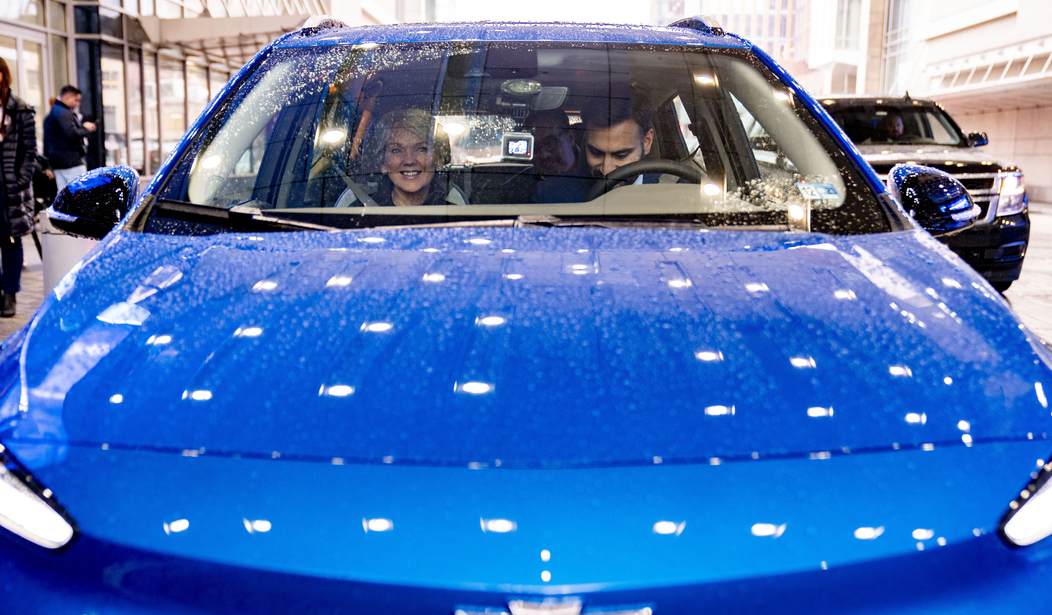"It’s hard not to get cold feet." —Joanne Marcotte, Inconvenient Doubts
The technology behind the production of EVs, which I regard as EVil, is in my estimation at least 10 years away from perfectibility. Meanwhile, EVs comprise a technical hazard, a convenience disaster, an energy cannibal, a financial liability, and a moral ignominy.
As the Western Standard reports, in Canada, “Big money — something like $52 billion in tax-payer dollars have been allocated to over 13 projects in the form of investment tax credits, production subsidies, and other supporting mechanisms, according to the Parliamentary Budget Officer.” Enacting an authoritarian policy, the federal government is pilfering tax revenues to fund the production and sale of EVs, subsidizing companies that have no accountability and buyers who have no practical sense.
What this means is that people who have no love for EVs but prefer to drive internal combustion engine (ICE) cars are subsidizing, through their government-funneled taxes, those who have opted for EVs. Once again, we observe the travesty of bureaucratic heavy-handedness and government overreach.
Additionally, Dan McTeague, president of Canadians for Affordable Energy, reminds us that when there is enough demand for a product, supply will soon follow. “In the case of EVs, however, the federal government is operating under the assumption that if you somehow create a supply, that will inspire a demand.” This rowback of economic principle never works.
Just as bad or worse, according to research specialist at Suncor Energy Joseph Fournier, “There is no energy transition in Canada.” In a 2022 report titled "The $2 trillion transition," the Royal Bank of Canada stated that power generation must increase by 50% over the next decade, if rolling blackouts are to be avoided. The same is certainly true in the U.S. and other Western nations. Relying on a radically insufficient infrastructure and the crippling inadequacy of the electrical grid is reckless in the extreme.
To begin with, “Grid infrastructure is not cheap,” warns Rupert Darwall in Green Tyranny: Exposing the Totalitarian Roots of the Climate Industrial Complex. Complicating the issue, a decarbonized energy generator, bringing “wind and solar intermittency, unpredictability and variability” in its train, renders the power supply not only unaffordable and insufficient, but wholly unreliable, “reversing the logic of the Industrial Revolution.”
According to the Ontario IESO (Independent Electricity Systems Operator), there is “insufficient time to plan, acquire and build the new generation and transmission infrastructure necessary to replace the natural gas generation” in order to meet current EV replacement targets. The resource shortfall may be insurmountable as demand will outstrip supply by a significant margin.
There are moral problems as well. Writing in American Thinker, Henry Pierson points out that “half of the world's supply of cobalt comes from the Democratic Republic of Congo,” which uses child labor, and that the necessary rare earth elements are almost entirely mined and refined in China, the world’s greatest polluter.” EV manufacture depends on slavers and polluters. Meanwhile, China proceeds to glut the Western EV markets while filling Democrat Party coffers in the U.S.
The technological side of the affair is no less troubling than the ethical and merits considerable attention. It is enough to put paid to the entire enterprise. Lithium-ion batteries represent a key technology that governments believe may enable mandated transitions to electric vehicles in many countries worldwide. But there remain several outstanding issues with lithium technology, including lifespan, cost and availability, battery performance at the extremes of ambient temperature, and the environmental impacts associated with the disposal of lithium battery components, whose toxic leakage can contaminate the soil and water table, as well as marine life. There is no such thing as the clean disposal of batteries.
Another major concern is safety. Lithium battery electrolytes typically consist of 10 to 20 liters of an organic carbonate mixture containing ~1 Molar dissolved LiPF6 salt (lithium hexafluorophosphate, mainly used as lithium-ion battery electrolyte). Quantities of electrolyte will vary according to the EV model and the type of battery cell in use — cylindrical, pouch, prismatic — but the figure quoted is a standard approximation. Organic carbonates are flammable and present significant risks should they overheat in a process called thermal runaway. Moreover, LiPF6 is highly reactive to water; exposure to even low levels of humidity from the atmosphere leads to the formation of several chemical byproducts including hydrofluoric acid (HF), a residue produced when LiPF6 comes in contact with water or humidity.
HF is an extremely toxic and dangerous chemical, which can also be easily volatilized. It corrodes internal battery components and degrades battery electrolyte stability. It poses a serious risk, as large amounts of highly dangerous HF gas (including hydrogen cyanide, sulphur dioxide, and methane) can be released in lithium battery fires, as was the case recently in South Korea where a lithium battery fire killed 22 people, almost instantly, due to thermal runaway of these hot lethal gasses.
In the automotive industry, HF has been referred to as “the chemical hazard hiding in electric and hybrid vehicle batteries.” For this reason, great care has to be taken in the construction and usage of lithium batteries to keep the electrolyte extremely dry and avoid any contact of the electrolyte with the atmosphere. A reliable way of neutralizing the threat has yet to be discovered.
EVs suffer from a number of additional problems that render their success extremely unlikely. These common deficiencies include limited travel range; long recharging periods; a paucity of recharging ports; high unit price, steep repair costs, and extortionate insurance rates; fire department upgrades; prohibitive cost of battery replacement (upward of $20,000); negligible resale value; and damage to tires, roads, bridges, etc. due to excess weight. The necessary rare earth metals, such as lithium, cobalt, graphite, nickel, and palladium, are labor-intensive, inherently noxious and exorbitantly expensive to extract.
The good news, Chris Queen reports for PJ Media, is that the EV fad appears to be dying out, and “auto manufacturers are beginning to adjust to the market.” Ford Motors, for example, is “backing away from EVs” and reconditioning an EV plant to build high-demand Super Duty trucks. Ford loses approximately $50,000 for every EV it sells. Nissan didn’t do much better, its EV earnings having dropped 99% in the first quarter of the year.
Stephen Green, citing the Wall Street Journal, celebrates General Motors’ decision to delay (perhaps indefinitely) the new Buick EV and a new electric truck factory.” Hertz Global Holdings has also seen the light, selling off 20,000 EVs from its fleet owing to weak demand and high repair costs. And as the Financial Post reports, “Volkswagen cuts EV output in Germany as demand craters.” The time has plainly come to end EV mandates and wasteful subsidies and incentives.
While most of our political leaders, to put it bluntly, are absolute chumps and globalist hacks who have little knowledge of either economics, technology, or business, Donald Trump is a rare exception. He understands the multiple downsides associated with electric vehicles. In his address at the Republican National Convention in Milwaukee, he vowed to “end the electric vehicle mandate on day one.” The choice should be up to the consumer rather than compelled by government fiat. The move, he said, would save “the U.S. auto industry from complete obliteration, which is happening right now, and sav[e] U.S. customers thousands and thousands of dollars per car.”
It would also, we might add, go a long way toward saving the environment for, as we have seen, EVs are overall polluters. As noted, they are not eco-friendly, despite what the propaganda industry would have us believe. Donn Dears’ eye-opening book "Clean Energy Crisis: The Challenge of Replacing Fossil Fuels" points out that the EV manufacturing process produces 46% of carbon emissions, while ICE vehicles produce 26%. Whatever way one looks at it, there is no upside to the EV craze.
According to the president of the Global Automakers of Canada David Adams, billions in subsidies plus private investments “have set such large-scale projects in motion already, and this is part of the reason it’s too late to turn back now…The die is cast.” Adams, however, may be blowing smoke. Corporate receivership and national default are the more likely prospects. Myth and reality are incompatible partners. A scalable model for a large consumer market is turning out to be a mirage. The market cannot sustain government-mandated folly and corporate fantasy. The collapse can’t come too soon.










Join the conversation as a VIP Member